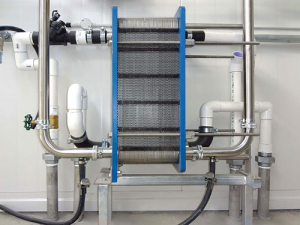Plate heat exchangers (PHE) are the most cost-effective way to cool milk, says DairyNZ.
A PHE consists of a series of very thin stainless steel plates. Water flows along one side of each plate while milk flows along the other; heat is transferred from the milk to the water via the plate.
The capacity of a plate cooler is adjusted by adding or subtracting plates.
The easiest way to check the effectiveness of a plate cooler is to compare the difference in the temperature of the incoming cooling water and the outgoing milk leaving the plate cooler.
An efficient PHE should cool milk to within 2°C of the water temperature before it enters the PHE. For example, if the temperature of the incoming cooling water is 14°C, the temperature of the milk exiting the plate cooler should be about 16°C.
Several factors affect the performance of pre-coolers; one is the flow rate of cooling fluid.
The system should be designed for the peak flow of milk expected from the milk pump. Water flow matched to the milk flow will make the plate cooler system easier to size and make efficient use of the cooling water.
M-series plate coolers work most efficiently with a water-to-milk flow ratio of 3:1, although 2:1 or even 1.5:1 is adequate for newer industrial models.
It pays to check the cooling fluid-to-milk flow rate ratio; use a bucket of known volume (e.g. a 20kg detergent container = a 23L bucket) and a stopwatch.
Flow rate (litres/second) is calculated by dividing the number of litres (L) by the time in seconds (sec) it takes to fill the bucket.
Turn on the plate cooler water pump and record the time taken to fill the bucket at the water discharge point. Measure at the discharge point to account for any flow rate restrictions in the pipework downstream of the plate cooler. Calculate the cooling water flow rate; for example, if it takes 15 seconds to fill a 23L bucket the flow rate is 23/15 = 1.5L/sec.
At the next milking, if it is easy to do, record the time taken to fill the bucket with milk at the tank entry point. For example, it may take 45 seconds to fill a 23L bucket (23 divided by 45 = 0.5L/sec).
Aim to take this measurement while the milk pump is working at capacity (i.e. lots of clusters attached to cows at peak milk flow, just after cupping up a whole side). For larger dairies and bottom loading tanks these measurements are best done using water (instead of milk) at a simulated milking.
Divide the cooling fluid flow rate by the milk flow rate to determine the ratio. In our example this would be 1.5 divided by 0.5 = 3. Therefore the cooling fluid flow rate is three times the milk flow rate – a ratio of 3:1. This ratio would indicate that the problem lies elsewhere as it is in the correct range.
Leave it to the experts
Cleaning the plates is not an easy task; it is time-consuming and best left to experts.
Inefficient systems may need resizing, extra pumping capacity, additional cooled water storage or a complete dismantle and service.
The additional capital and service costs should be considered against the annual costs of using an inefficient plate cooler.
The cost of an inefficient plate cooler increases in proportion to the annual milk production of the farm.


















